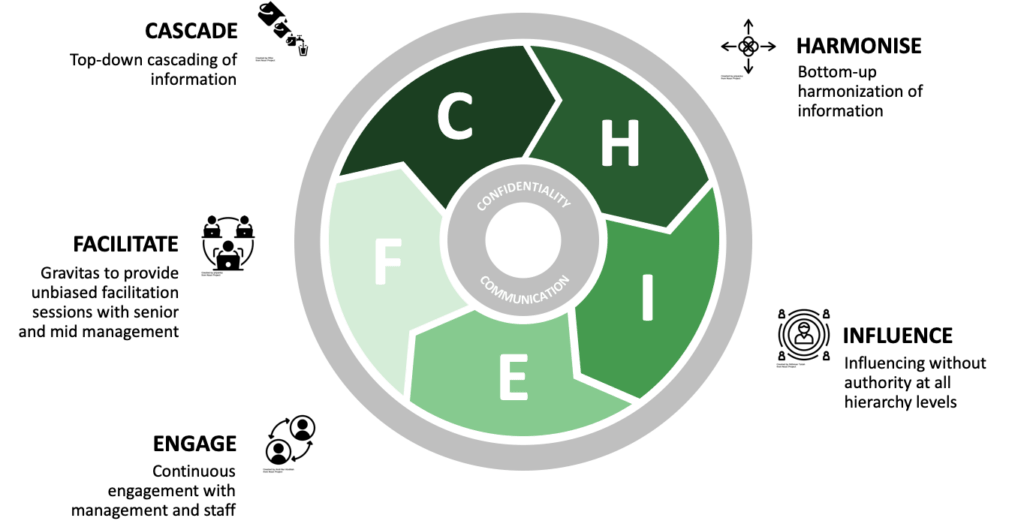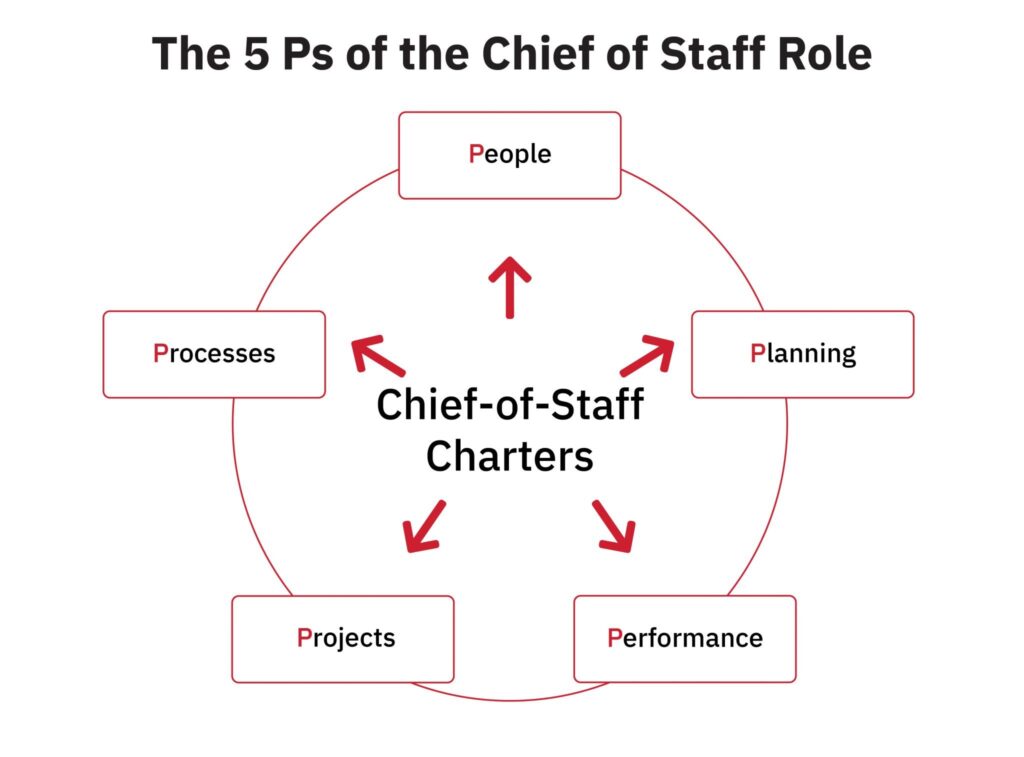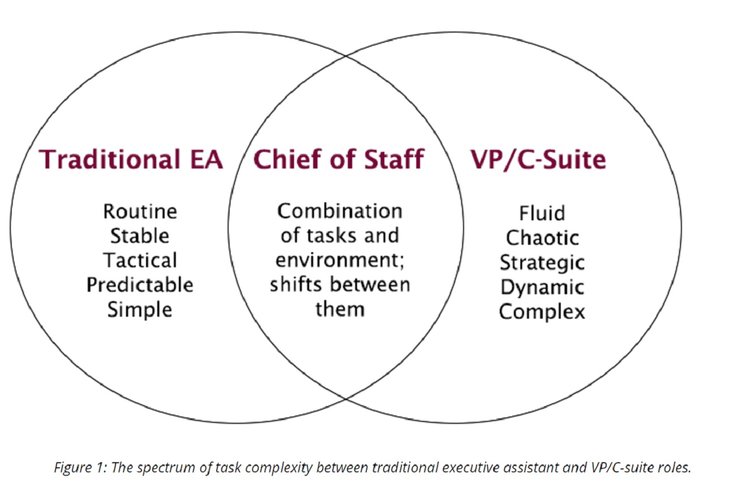The position of Chief of Staff (CoS) within an organization is often likened to the conductor of an orchestra, orchestrating harmony among various departments and ensuring that the business operates seamlessly. This pivotal role is characterized by a unique blend of leadership, strategy, and execution, making it one of the most crucial positions in any successful organization.

Strategic Adviser: The Chief of Staff serves as a key strategic adviser to the top leadership, offering insights, recommendations, and analysis that contribute to informed decision-making. By closely collaborating with executives, the CoS helps align organizational goals with day-to-day operations, fostering a strategic mindset throughout the company.
Example: Google: CoS as Strategic Adviser
Google, known for its innovative approach to business, has a history of utilizing the Chief of Staff role effectively. In the early 2000s, Sheryl Sandberg served as Chief of Staff to then-CEO Eric Schmidt. Sandberg played a pivotal role in shaping Google’s strategy, acting as a strategic adviser and helping the company navigate its rapid growth. Her insights and coordination laid the groundwork for Google’s success in the following years.
Effective Communication & Crisis Management : Communication is the lifeblood of any organization, and the CoS acts as a central hub for information flow. They ensure that critical messages are disseminated efficiently across various levels, departments, and stakeholders. This role helps maintain transparency, mitigates miscommunication, and fosters a cohesive work environment.
In times of crisis or uncertainty, the Chief of Staff becomes a linchpin in navigating challenges. Their ability to remain calm under pressure, make swift decisions, and implement crisis management plans can be instrumental in safeguarding the organization’s reputation and resilience.
Example: Facebook: CoS in Crisis Management
At Facebook, the Chief of Staff role took on significance during a period of crisis. During the Cambridge Analytica scandal, Zuckerberg’s Chief of Staff, Renee James, played a crucial role in managing the fallout. James helped coordinate the company’s response, liaised with stakeholders, and implemented measures to address privacy concerns. This exemplifies how the CoS can be instrumental in crisis management, protecting the company’s reputation and guiding it through turbulent times.
Operational Efficiency: In the dynamic landscape of business, operational efficiency is paramount. The Chief of Staff plays a crucial role in streamlining processes, identifying bottlenecks, and implementing improvements. This proactive approach enhances the overall efficiency of the organization, enabling it to adapt and thrive in a competitive environment.
Example: Salesforce: CoS in Operational Efficiency
Salesforce, a leader in customer relationship management, has showcased the impact of the Chief of Staff in enhancing operational efficiency. Salesforce’s CEO, Marc Benioff, appointed Parker Harris as his Chief of Staff. Harris played a key role in streamlining internal processes, improving communication across departments, and ensuring that strategic initiatives were effectively executed. This focus on operational efficiency has contributed to Salesforce’s sustained growth and market leadership.
Project Management and Execution: The CoS is often tasked with overseeing key projects and initiatives, ensuring that they align with the organization’s strategic objectives. By coordinating efforts across teams, the Chief of Staff facilitates successful project execution, driving results and contributing to the achievement of organizational milestones.
Example: Tesla: CoS in Project Management
Tesla, led by Elon Musk, is renowned for its ambitious projects and rapid innovation. Musk’s Chief of Staff, Gwynne Shotwell, exemplifies the CoS role in project management. Shotwell has been instrumental in overseeing critical projects such as the development and launch of the Tesla Model S. Her ability to coordinate efforts across engineering, manufacturing, and marketing has played a significant role in Tesla’s success in the electric vehicle market.
Talent Development and Team Building: A strong organizational culture begins with effective leadership and team dynamics. The CoS plays a vital role in talent development, identifying key individuals for leadership positions and fostering a collaborative work environment. This not only contributes to employee satisfaction but also enhances overall productivity.
Example: Amazon: CoS in Talent Development
Amazon, known for its customer-centric approach and rapid expansion, has leveraged the Chief of Staff role for talent development. Jeff Bezos’ Chief of Staff, Andrew Jassy, played a crucial role in identifying and nurturing leadership talent within the company. Jassy’s efforts in talent development contributed to the success of Amazon Web Services (AWS), showcasing the impact of the CoS in building a strong and capable leadership team.
Time Management for Leadership: Executives at the helm of an organization often find themselves inundated with a myriad of tasks. The Chief of Staff takes on the responsibility of managing the leader’s time efficiently, prioritizing activities, and ensuring that their focus remains on strategic initiatives.
Example: Apple: CoS in Time Management
Apple, under the leadership of Steve Jobs, demonstrated the importance of effective time management through the Chief of Staff role. Jobs appointed Tim Cook as his Chief of Staff, a position in which Cook excelled at managing day-to-day operations. Cook’s efficient time management allowed Jobs to focus on product innovation and strategic vision, contributing to Apple’s transformation into one of the most valuable companies globally.

How Chief of Staff role helps the CHRO or CPO?
In the dynamic landscape of modern organizations, the role of Chief Human Resources Officer (CHRO) has evolved beyond traditional HR functions to become a strategic partner in shaping an organization’s success. To enhance the impact and effectiveness of the CHRO, the Chief of Staff (CoS) to the CHRO plays a pivotal and increasingly crucial role. This article explores how the CoS to CHRO is integral to organizational success and the advancement of human resources strategies.
1. Strategic Alignment:
- Role of the CoS: The CoS to CHRO acts as a bridge between the CHRO and other C-suite executives, ensuring that human resources strategies align with overall organizational goals.
- Impact: This alignment facilitates the integration of HR initiatives into the broader business strategy, promoting a cohesive approach that drives organizational success.
2. Organizational Development:
- Role of the CoS: The CoS collaborates with the CHRO on initiatives related to organizational development, talent management, and workforce planning.
- Impact: By actively participating in the development and execution of these strategies, the CoS contributes to creating an agile and high-performing workforce, which is vital for the sustained success of the organization.
3. Communication Facilitation:
- Role of the CoS: The CoS ensures effective communication between the HR department and other organizational units, fostering collaboration and understanding.
- Impact: Improved communication enhances the implementation of HR policies, programs, and initiatives, creating a harmonious work environment and supporting employee engagement.
4. Strategic Decision Support:
- Role of the CoS: The CoS provides valuable insights and support to the CHRO in strategic decision-making related to human capital management.
- Impact: With informed decision support, the CHRO can implement policies that attract and retain top talent, ensuring the organization remains competitive in the talent market.
5. Change Management:
- Role of the CoS: The CoS to CHRO plays a critical role in change management, particularly in the implementation of HR-related changes and initiatives.
- Impact: This involvement ensures that organizational changes, whether in HR policies or practices, are smoothly executed, minimizing disruptions and enhancing employee acceptance.
6. Diversity and Inclusion Initiatives:
- Role of the CoS: The CoS actively supports the CHRO in championing diversity and inclusion initiatives within the organization.
- Impact: By fostering a diverse and inclusive workplace, the CoS contributes to a positive organizational culture, improving employee satisfaction, and promoting innovation.
7. Talent Acquisition Strategy:
- Role of the CoS: The CoS collaborates with the CHRO to develop and execute talent acquisition strategies that align with the organization’s growth objectives.
- Impact: Strategic talent acquisition is vital for ensuring the organization has the right people in the right roles, driving innovation, and maintaining a competitive edge.
8. Employee Well-being and Engagement:
- Role of the CoS: The CoS supports the CHRO in initiatives focused on employee well-being, engagement, and overall satisfaction.
- Impact: A positive workplace culture, facilitated by these initiatives, enhances employee morale, productivity, and loyalty, contributing to the organization’s overall success.

Other Chief of Staff roles:
Chief of Staff to Chairman:
- Strategic Adviser: Serving as a strategic adviser to the Chairman, providing insights and recommendations on key organizational decisions and initiatives.
- Board Relations: Facilitating communication and coordination between the Chairman and the board of directors, ensuring alignment with the organization’s strategic goals.
- Stakeholder Management: Managing relationships with external stakeholders, government entities, and other influential figures to enhance the organization’s reputation.
Chief of Staff to CEO:
- Executive Support: Providing comprehensive support to the CEO, managing schedules, preparing for meetings, and ensuring the CEO’s time is optimized for strategic priorities.
- Communication Hub: Acting as a central point of contact for communication within the executive team, ensuring seamless information flow.
- Strategic Initiatives: Overseeing key strategic initiatives, collaborating with department heads, and ensuring alignment with the CEO’s vision.

Chief of Staff to CFO:
- Financial Strategy: Assisting in the development and execution of financial strategies aligned with the organization’s overall goals.
- Budget Oversight: Managing budgetary processes, overseeing financial planning, and ensuring effective allocation of resources.
- Risk Management: Collaborating on risk management strategies, ensuring compliance with financial regulations, and supporting the CFO in decision-making related to financial matters.
Chief of Staff to CIO:
- Information Technology Strategy: Assisting in the development and execution of information technology strategies that align with business objectives.
- Cybersecurity Oversight: Managing cybersecurity initiatives, ensuring the organization’s digital assets are secure from potential threats.
- IT Innovation Support: Collaborating with the CIO to foster a culture of innovation within the IT department and exploring emerging technologies.
Chief of Staff to CCO (Chief Compliance Officer):
- Regulatory Compliance: Assisting in the development and implementation of strategies to ensure the organization complies with relevant regulations.
- Ethics and Compliance Programs: Overseeing programs to promote ethical behavior and compliance within the organization.
- Internal Investigations: Managing internal investigations and ensuring adherence to ethical standards and legal requirements.
Chief of Staff to CDO (Chief Diversity Officer):
- Diversity and Inclusion Strategy: Assisting in the development and execution of strategies to promote diversity and inclusion within the organization.
- Training and Education: Overseeing initiatives to educate employees on diversity and inclusion topics and promote a culture of understanding and respect.
- Metrics and Reporting: Managing the collection and analysis of data related to diversity and inclusion metrics, ensuring progress is measured and communicated.

How Chief of Staff role is different from EA?
The Chief of Staff role differs from that of an Executive Assistant (EA) in several ways:
- Strategic Focus: The Chief of Staff typically has a more strategic and wide-ranging focus, involved in decision-making, strategy development, and operational oversight. An EA, on the other hand, often handles administrative tasks and supports the executive in day-to-day activities.
- Project Management: Chiefs of Staff often take on project management responsibilities, overseeing key initiatives and ensuring their successful implementation. EAs are more likely to handle administrative tasks, such as scheduling and travel arrangements.
- Decision-Making Influence: The Chief of Staff often has a more significant role in advising and influencing decisions at a strategic level. EAs are more likely to act as a support system, executing tasks assigned by the executive.
- Cross-Functional Collaboration: Chiefs of Staff often work across departments, fostering collaboration and ensuring alignment with organizational goals. EAs may primarily focus on the needs of the executive they support.
The Chief of Staff roles for various C-suite executives involve a mix of strategic planning, project management, and cross-functional collaboration. While EAs provide crucial administrative support, Chiefs of Staff are strategic partners, actively contributing to the executive’s decision-making and the organization’s overall success.

Future of the role of Chief of Staff
The future of the Chief of Staff (CoS) role is poised to undergo significant evolution as organizations adapt to emerging trends, challenges, and changing work dynamics. Several factors will shape the future of this pivotal position:
- Digital Transformation: The ongoing digital transformation is reshaping the way organizations operate. As technology continues to advance, the CoS will likely play a crucial role in navigating digital disruptions, integrating new technologies, and ensuring that the organization remains agile and competitive in the digital era.
- Data and Analytics Integration: With the increasing importance of data-driven decision-making, the CoS is likely to become more involved in leveraging data and analytics. This includes utilizing data to inform strategic decisions, identify operational inefficiencies, and measure the impact of various initiatives, contributing to a more informed and agile organization.
- Remote Work and Virtual Collaboration: The rise of remote work and virtual collaboration has become a prominent feature of the modern workplace. The CoS will need to adapt to managing teams dispersed across different locations, ensuring effective communication, collaboration, and maintaining a cohesive organizational culture in a virtual environment.
- Focus on Inclusivity and Diversity: As organizations prioritize inclusivity and diversity, the CoS will play a key role in ensuring that these values are embedded in the organizational culture. This involves championing diversity initiatives, fostering an inclusive work environment, and promoting equal opportunities for all employees.
- Adaptive Leadership and Change Management: The future CoS will need to excel in adaptive leadership and change management. Rapid changes in the business environment, whether due to economic shifts, global events, or industry disruptions, will require the CoS to guide the organization through transitions and foster a culture that embraces change.
- Environmental, Social, and Governance (ESG) Initiatives: With a growing emphasis on corporate social responsibility, the CoS is likely to play a role in driving ESG initiatives. This involves integrating sustainability practices, ethical considerations, and social responsibility into the organization’s strategy, aligning business objectives with broader societal goals.
- Strategic Partnership and Stakeholder Management: The CoS will continue to be instrumental in managing relationships with key stakeholders. This includes fostering collaboration with external partners, government entities, and non-profit organizations to enhance the organization’s reputation, navigate regulatory landscapes, and contribute to sustainable growth.
- AI and Automation Integration: The integration of artificial intelligence (AI) and automation into various aspects of business operations will require the CoS to understand and leverage these technologies effectively. This includes identifying opportunities for automation, managing the impact on the workforce, and ensuring a smooth transition to a technology-enhanced workplace.
- Enhanced Skill Set: As the role becomes more multifaceted, the future CoS may need an expanded skill set. This could include proficiency in data analysis, digital literacy, change management, cultural competency, and a deep understanding of emerging technologies.
- Continued Adaptation to Industry-Specific Challenges: Industry-specific challenges and trends will also influence the evolution of the CoS role. Different sectors will demand unique skill sets and priorities, requiring CoS professionals to tailor their approach based on the specific needs of their industry.
In summary, the future of the Chief of Staff role will be dynamic and adaptive, driven by technological advancements, changing work dynamics, and evolving organizational priorities. Those in this role will need to continuously acquire new skills, embrace innovation, and lead with resilience to guide their organizations through an ever-evolving business landscape.











